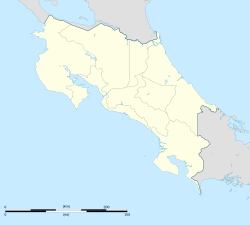Tobosi facts for kids
Quick facts for kids
Tobosi
|
|
|---|---|
|
District
|
|
| Country | |
| Province | Cartago |
| Canton | El Guarco |
| Area | |
| • Total | 19.9 km2 (7.7 sq mi) |
| Elevation | 1,380 m (4,530 ft) |
| Population
(2011)
|
|
| • Total | 6,569 |
| • Density | 330.1/km2 (855.0/sq mi) |
| Time zone | UTC−06:00 |
| Postal code |
30803
|
Tobosi is a special area called a district. It is part of the El Guarco area, which is in the Cartago province of Costa Rica. You can find Tobosi about 3 miles southwest of the city of Cartago. It is also known as San Juan de Tobosi. St. John the Evangelist is considered the town's special protector.
Contents
History of Tobosi
Tobosi is one of the oldest towns in Costa Rica. It was started around 1575 by Spanish leaders and Franciscan friars. They created it as a "reduction," which was a special village for indigenous people. About one hundred people lived there at first. Some people think it started with one hundred families instead.
Early Life and Changes
Until 1826, only indigenous people lived in Tobosi. These were people from the Huetar group. Because Tobosi was close to the city of Cartago, its people often had to work for the Spanish. Over time, they started to lose their original language, unique dress, and traditional customs.
Laws to Protect Indigenous People
In 1568, the Spanish King, Phillip II, made new laws. These laws aimed to protect indigenous people from being treated unfairly. Before this, Spanish explorers, called conquistadors, often forced indigenous people to work for them. The new laws said that owning indigenous people as slaves was against the rules.
Instead, villages or tribes were supposed to pay a set amount of money. This money would then be given to the Spanish settlers. However, the conquistadors did not like these new rules. In 1569, a governor named Pero Afán de Ribera y Gómez ignored the king's laws. He illegally divided the indigenous people, including those near Cartago, among about forty Spaniards.
Losing Self-Governance
During the time Spain ruled, Tobosi had its own local government. This was like a small town council or municipality. But in 1836, the government led by Braulio Carrillo Colina ended this local council. Like other indigenous communities in Costa Rica's Central Valley, the people of Tobosi also lost their shared lands. These lands were taken and sold to others.
Geography of Tobosi
Tobosi covers an area of about 19.9 square kilometers (about 7.7 square miles). It is located at an elevation of about 1,380 meters (4,528 feet) above sea level.
Villages in Tobosi
The district of Tobosi includes several smaller villages. These are:
- Achiotillo
- Barrancas
- Bodocal
- Garita
- Purires
- Tablón
Population of Tobosi
The number of people living in Tobosi has changed over the years. Here is how the population has grown:
| Historical population | |||
|---|---|---|---|
| Census | Pop. | %± | |
| 1883 | 814 | — | |
| 1892 | 755 | −7.2% | |
| 1950 | 1,179 | — | |
| 1963 | 1,467 | 24.4% | |
| 1973 | 2,161 | 47.3% | |
| 1984 | 2,833 | 31.1% | |
| 2000 | 5,418 | 91.2% | |
| 2011 | 6,569 | 21.2% | |
|
Instituto Nacional de Estadística y Censos |
|||
According to the 2011 census, Tobosi had a population of 6,569 people.
Transportation in Tobosi
Road Connections
The district of Tobosi is connected by roads. The main road that goes through the area is:
Economy of Tobosi
The people of Tobosi work in several important areas. The main ways they earn a living are through agriculture, which means farming. They also work with livestock, raising animals. Some people create handicrafts, making things like baskets and rope by hand.
See also
 In Spanish: Tobosi para niños
In Spanish: Tobosi para niños


